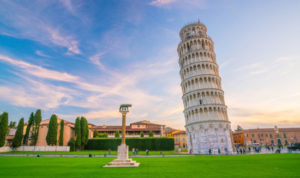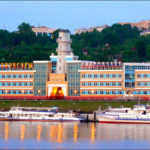18 interesting facts about the Leaning Tower of Pisa
 Among all the towers of the world, it is Pisa, perhaps, is one of the most famous, along with the Eiffel. Because of its unusual slope, it is called “falling”, because visually it really seems that it is about to fall. And, by the way, it really could have fallen already if it had not been for restoration work that allowed us to preserve this unique architectural monument.
Among all the towers of the world, it is Pisa, perhaps, is one of the most famous, along with the Eiffel. Because of its unusual slope, it is called “falling”, because visually it really seems that it is about to fall. And, by the way, it really could have fallen already if it had not been for restoration work that allowed us to preserve this unique architectural monument.
It has no roof, but there is an observation deck at the top. But from the very first floor, looking up, you can see the sky.
In Russia there are as many as two falling towers, Syuyumbike and Nevyansk. But they, of course, are not as famous as the Leaning Tower of Pisa.
The Leaning Tower of Pisa is part of the cathedral, and in its interior there are several tombs.
At a height, the walls of the Leaning Tower of Pisa are thinner than at the base. On the ground floor they are almost five meters thick.
In the Italian city of Pisa, which gave the name to the Leaning Tower of Pisa, there are as many as three such falling towers, because the soil in this region is quite soft. However, the other two are less widely known.
Now the leaning angle of the Leaning Tower of Pisa is about 4 degrees. At the end of the 20th century, it bent to almost 10 degrees, and there really was a risk of its fall, but restoration work was carried out, and the tower was slightly straightened, along the way strengthening the soil around its base.
The bell tower at the top of the Leaning Tower of Pisa was built later, when the tower was already leaning, so it really seems to be curved relative to the tower itself.
Shortly after construction, the tower tilted north, but due to the nature of the soil, later it first straightened on its own and then tilted south.
The names of the architects who built the Leaning Tower of Pisa are still not known for certain.
In the American city of Chicago there is a water tower, which is a half-sized copy of the Leaning Tower of Pisa.
The bell tower on top of the Leaning Tower of Pisa is equipped with seven bells, each of which is tuned to a specific note.
Currently, the top of the leaning tower is tilted by about 5 meters relative to its base.
The mass of the Leaning Tower of Pisa reaches almost 14,500 tons.
At first, it tilted by 2-3 millimeters annually, but after reaching a certain angle of inclination, the rate of fall of the Leaning Tower of Pisa increased. Since then, she has been repeatedly corrected.
They built the tower intermittently, spending a total of almost two hundred years on the construction.
There are 294 steps leading to the top of the Leaning Tower of Pisa in order to reach the observation deck around the bell tower.
The famous scientist Galileo, according to surviving records, conducted his research here. In particular, he threw down various objects and carefully documented everything.
For restoration work carried out at the turn of the millennium, the Leaning Tower of Pisa was closed for eleven years.



























